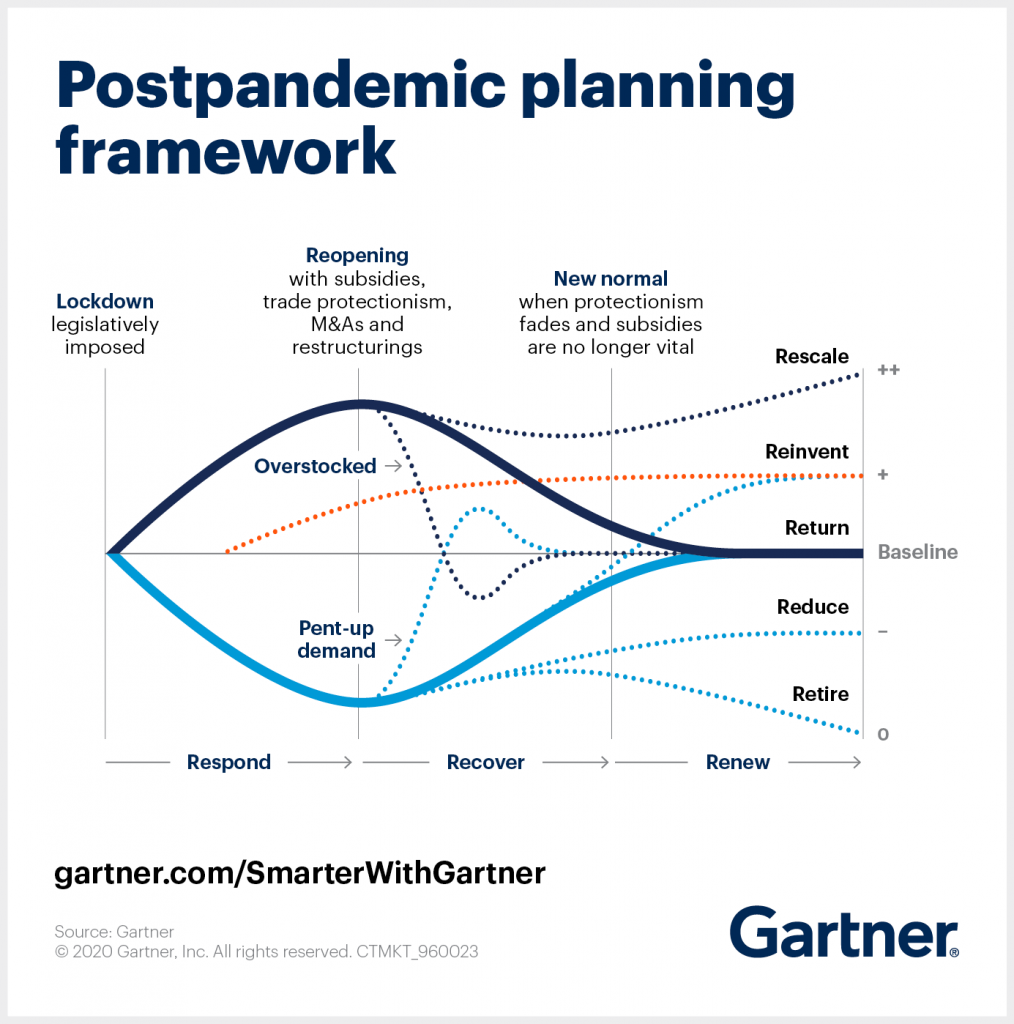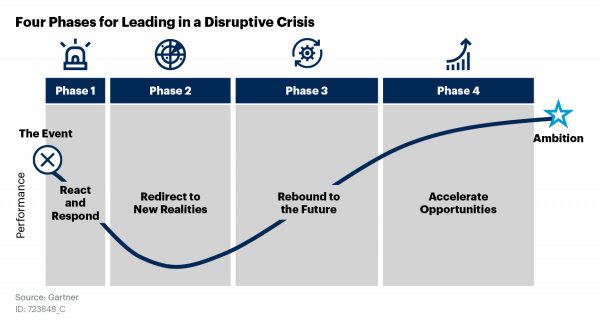Collaboration is like a populated ocean, a giant and immaterial extension of complex communication systems, which enable the effective interaction of its habitants.” Exponential Agility (2020).
In this phase, if we have followed the previous steps, increasing the capabilities of the business, what we will obtain is a business, mature and sustained in agile to be able to scale, remember that what we scale is collaboration, and the other capabilities, maturity is an objective. What we want is to keep productivity and investments as uniform as possible throughout our initial agile environment (more than 3 scrum teams), to achieve this, we need to scale a set of mature initiatives and their interaction between them.
As we have seen, there are different types of scaling, vertical scaling, focused on maximizing the value of a specific initiative until it becomes an exponential initiative or organization.
8.Agile at Scale
Horizontal scaling, which aims to achieve a goal with a very large scope at the extended enterprise level, to coordinate the integration of the value generated by hundreds of participating teams in synthesized value streams. Scaling up is an adaptive change challenge, full of “wicked problems,” as design thinking describes, that are unique to each organization. Remember that we must work deliberately and intentionally on creation, maturity, and stabilization. of collaboration, since it is what we are going to scale, through sustained development and growth.
Every organization is different, although scaling is related to collaboration, we scale it, if we have problems in our collaboration approaches, both vertical and horizontal, we will scale them to their maximum potential for dysfunctionality and that is not what we want. What we want is to keep productivity and investments as uniform as possible throughout our initial agile environment (more than 3 scrum teams), to achieve this, we need to scale a set of mature initiatives and their interaction between them.
Therefore, we can outline a scaling meta-backlog (Similar to what is described in this series of articles), so that each cycle (that is, each month) we can validate our main hypothesis together with escalation experts to guide our initiative ” Escalation MVP”. We may not even need to scale if we can achieve higher productivity with the equipment we already have. Do agile with agile, not climb agile with waterfall, does it exist?
Figure 1: Agile Scaling Roadmap MVP.

Source: Miguel Martínez (2020). Own Elaboration.
A scaling challenge is similar to a business escalation, for us it will be an “intra-business escalation”, where we have peaks and valleys, which we must identify, to overcome the obstacles and achieve the future state, remember that we should execute agile with agile, with the objective that the capacities built are the base of the following ones, thus creating an environment of sustained collaboration.
Figure 2: The Nexus Scaling Framework.
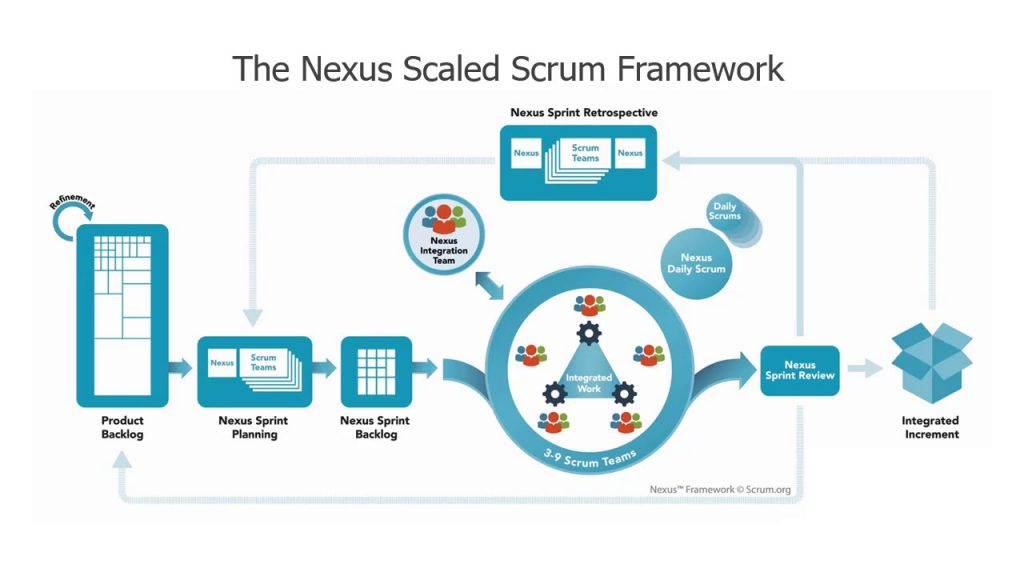
Source: Scrum.org.
The center of scaling resides in identifying, minimizing and removing dependencies, only with a firm foundation can we scale successfully. In reality, we can produce less and be less efficient for a time, as teams face the additional complexities that scaling brings, so maturity of the agile environment is important before scaling, because there will be fewer obstacles and we will also have strong teams to overcome them.
Figure 3: The LeSS Scaling Framework.

Source: less.works
As such, it’s important to get the most out of the teams we currently have and help them become more efficient and effective before looking to scale their efforts. Before we start climbing, we must seek to achieve more, with what we already have.
Figure 4: The SAFE Scaling Framework.
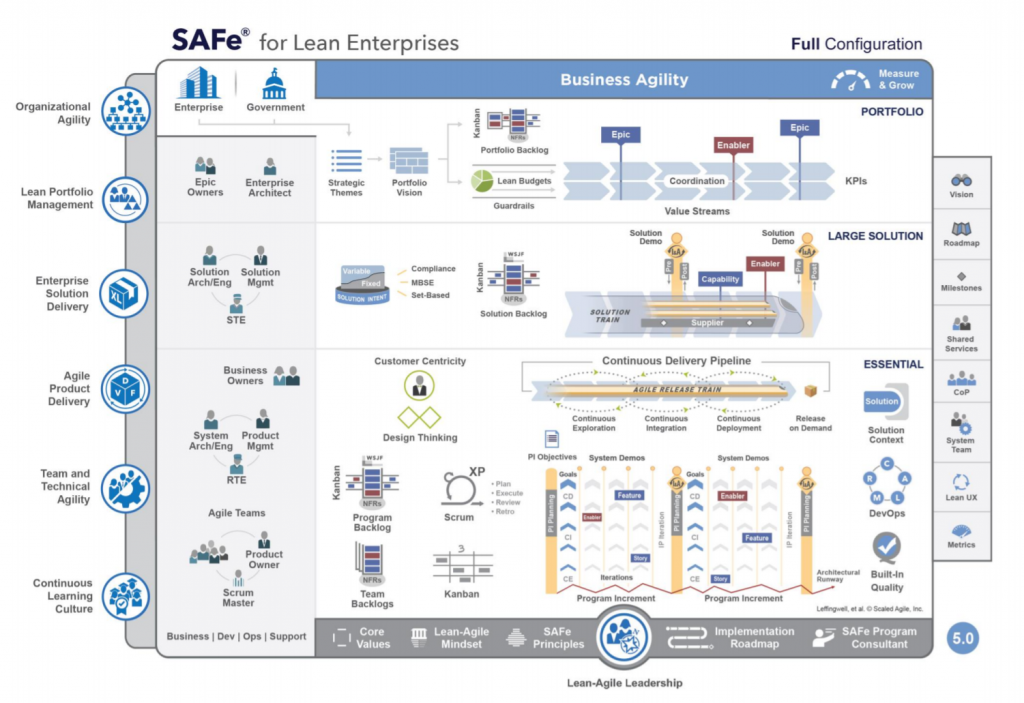
Source: scaledagileframework.com
At this point, it is very important that investment management is connected to the strategic themes of the organization, which will be our northern stars to follow, to contribute or directly achieve the business objectives. We will develop this topic extensively in future articles.
9.Extension of Blueprints or strategic themes.
Lean portfolio management provides us with a higher-level planning perspective in an agile framework, and refers to the definition, refinement, prioritization and financing of business initiatives for implementation by delivery teams and programs. These initiatives are regularly referred to as epic and once approved at the portfolio level, they translate into implementable features, which must be realized by delivery program teams. A program is a collection of linked products, involving multiple teams of collaborators.
Each business unit within a company will have a portfolio of income generating products and / or services. Each portfolio is guided by a strategy, or set of Strategic Themes, and supported by the people and processes necessary to carry out that strategy. Portfolio-level artifacts include:
Strategic themes, epics (business epics and enablers), a Portfolio Kanban and a Portfolio Backlog. Defines the total set of actions required to take a product / service from its characterization to its commissioning.
Figure 5: Portfolio based on strategic themes.
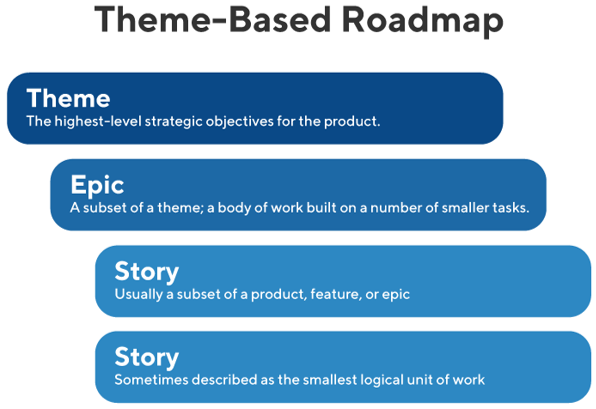
Source: productplan.com/theme-based-roadmap/
Institutional alignment includes organizational leadership, knowledge of the vision, strategy and tactics of the business, and the alignment of each program, vision, strategy and product tactics as a value stream, the commitment of the various stakeholders is very important. in the process in order to maintain flexibility and stability of the strategy at the same time, a practice that helps us to keep an environment aligned and prepare it to scale is the practice of agile product management, since the artifacts that it generates will allow us to integrate the value of each of the initiatives at the time of executing the corresponding value flows.
When we work on the creation of an agile work environment, it is very important that business leaders, at the management level, know the value of agility and know how to leverage it to obtain strong results, culture should not eat strategy at breakfast , the leaders are the ones in charge of this not happening and they are the ones who will set the example in the co-creation of these capacities.
As a practical experience in a transformation, when interacting at this level: “It was the first of several meetings we held in this regard, our agenda consisted of socializing the vision, strategy and tactics of about 15 products / services in a digital business unit banking, we had to share the vision and strategy, aligned with the bank’s transformation strategy, it was our first early step towards imminent scaling, we had been using Nexus as a work base and we sought to complement it with a Lean Portfolio Management practice. In the first three presentations, the executives present in the session were not used to the level of transparency shown, they did not understand why there should be strategy at that level, because it had to be repeated, the strategy at that time only corresponded to the CEO and his staff , to no one else, the culture was siloficated, with about 10 bastions, who served as the CEOs of their business units, which were managed by results and each one separately, there were projects that overlapped and one of the CEO’s tasks was to identify them, but ultimately the culture is planned because the strategy was divided and not transparent, I remember that the first session lasted until the executives present requested the signing of the commitments that were established in the agile roadmaps of each product, these they should not change and the perspective should be at least 1 year ”, those were the indications. Carrying out an inspection and adaptation of this session, we proceeded to identify the elements for improvement, it took approximately 3 to 6 months, in each case, to change this perspective through awareness, training at these levels, training in agile strategy and product management. The next session, in the following 3 months, was much better for us, we had an attendance of at least 10 interested parties at the executive level, with a previous syncretic preparation, in which we previously reviewed the relevant points to show, the problems and the decisions to be made In a synthetic and executive way, only one case had to rework the information of an initiative. That was a key planning of how we began to modify the culture and win the required commitments at the management level.
Figure 6: Strategic Issues in SAFE.
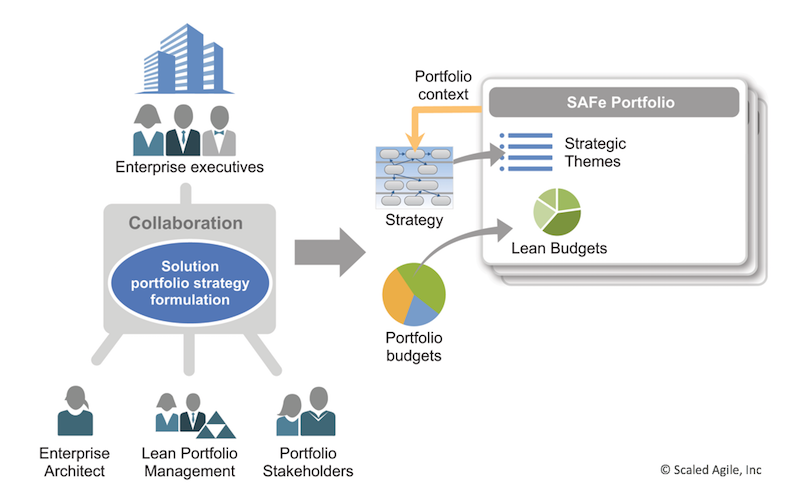
Source: www.scaledagileframework.com/strategic-themes/
One of the next steps implied that just as we had created teams at the operational level, at the tactical level, it was important to create prioritization teams at the strategic level, self-organized teams, with roles similar to scrum or Kanban, but where decisions about the products and experiments were collegiate, as well as the funding of various projects, finally they applied Scrum or Kanban, but at another level, it was necessary to talk with these teams at the level of investments, benefits, customer impact, financial business, cost reduction, savings, recovery of investments, risks, scrum or Kanban being the same base but personalized to the context where we were located, this allowed us to create portfolio prioritization teams at a strategic level, which allowed great progress in the transformation with respect to the flattening of hierarchical structures, obviously there were always antagonistic figures that gave us greater impetus in the better pray continue.
Today we will move on to here, if you have any questions or comments about it, feel free to contact us directly and ask us.
Many greetings.
Miguel A. G. Martínez H., September 2020,
Bibliography:
- AG, D. (2020, March 10). Respond and Recover | Crisis management in unprecedented times. Retrieved August 20, 2020, from https://www2.deloitte.com/us/en.html
- Allas, T., Sjatil, P. E., Stern, S., & Windhage, E. (2020, April). How European businesses can position themselves for recovery. Retrieved September 10, 2020, from https://www.mckinsey.com/
- Dreyfus model of skill acquisition. (2020, June 18). Retrieved September 18, 2020, from https://en.wikipedia.org/wiki/Dreyfus_model_of_skill_acquisition
- Mahadevan, D. (2018, February 20). ING’s agile transformation. Retrieved September 19, 2020, from https://www.mckinsey.com/industries/financial-services/our-insights/ings-agile-transformation
- Mitchell, C. (n.d.). The Conference Board – TCB C Suite Challenge 2020 Covid19 Recovery. Retrieved September 10, 2020, from https://conference-board.org/us/
- LEANTALK, 2020. The Ultimate Lean Talk Forum And Blog- About Us. [online] Leantalk.org. Available at: <https://leantalk.org/about-leantalk-org> [Accessed 14 September 2020].
- One, V. (n.d.). 14th Annual State of Agile Report. Retrieved September 10, 2020, from https://stateofagile.com/
- O’rreally, B. (2020, May 11). Scaling Innovation Means Descaling Work. Retrieved September 10, 2020, from https://barryoreilly.com/resources/
- Saenz, H., Supko, M., & O’Keefe, D. (n.d.). Why Return to “Normal” When You Can Recover to a Winning Position? Retrieved September 10, 2020, from https://www.bain.com/
Read more




















